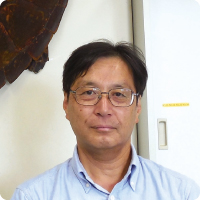- Notice
Learning about biology through experiments using DNA - More genetic modification experiments for high school students! ~ (Japanese only)
2013.12.03
Tokyo Metropolitan Shinjuku High School Yukio Sato, Teacher
In 2001, Dr. Sato helped researchers at the University of Tsukuba and the University of Tokyo develop guidelines for genetic modification experiments for educational purposes. He actively holds training sessions for teachers, and in his own classes, he has actively introduced DNA extraction experiments and bioluminescence experiments using enzymes produced by genetic recombination in the basic biology class, as well as DNA cleavage experiments using restriction enzymes and genetic recombination experiments for biology elective students. We asked Dr. Sato about the perspective from which he views biology in his classes.

A little questioning expands what can be learned through experimentation.
Experiencing genetic modification and DNA extraction is not the only important thing, says Dr. Sato. For example, if you just extract DNA and look at the white blur, you may just say, 'Hmmm. The reason DNA is soluble in water is because phosphoric acid is located on the outside of the helical structure, and the reason nuclei are stained with a basic dye is because nuclei contain nucleic acids that are acidic when dissolved in water. The reason why the nucleus is stained with basic dyes is because it contains nucleic acids that are acidic when dissolved in water. Dr. Sato emphasizes the importance of giving precise attention and explanations during experiments so that what students learn in biology class about the structure of DNA, as well as what they have learned in other subjects such as chemistry, clicks into place during experiments. This alone makes the experiments much more meaningful.
Everything you learn in biology is connected to how DNA works.
The purpose of the university professors' cooperation in creating guidelines for genetic modification experiments was to create an environment in which students could experience genetic modification in an educational setting, so that they could think about biotechnological techniques with an understanding of the technology, rather than thinking "I don't understand it, so it's dangerous". However, Dr. Sato believes that this is not the only advantage of incorporating this experiment into high school classes. The genetic modification experiment used in the class is to create a glowing E. coli. Genes are not always expressed, but a switch must be activated to regulate their expression, and the same is true for the genes recombined in the E. coli. Dr. Sato likes the fact that he can learn about the regulation of gene expression through the genetic recombination experiment. When you understand the regulation of gene expression, you can understand various phenomena in living organisms," he said. If you learn about development and metabolism separately, it is difficult to remember them, but if you understand this mechanism, they are all connected as a single mechanism. If you do this, I think you will understand that living organisms are very easy to understand," he says.
Research on teaching materials still continues.
What Dr. Sato is now trying to do is to develop experimental materials that make people realize that phenotypes change when genes change. He will conduct an experiment using PCR and restriction enzymes to examine the genes of wild Arabidopsis thaliana and double-flowered Arabidopsis. We want them to grow their own Arabidopsis and realize that the shape of the flower is determined by DNA. Also, even if the phenotype is wild-type, if we detect individuals heterozygous for the double-flowering gene and sow seeds made from them, single-flowering wild-type and double-flowering should grow in a 3:1 ratio, and I think this will be a good teaching tool to connect DNA and Mendelian inheritance. We were not able to detect it very clearly this time, but we will try again," said Sato. Each of the experiments conducted by the professor may seem too advanced to be conducted in class, but in fact, they are experiments that lead to an understanding of the fundamentals that connect the mechanisms of diverse organisms at the base.
Article in the September 2013 issue of Kyoiku Ouen, a science education information magazine
Affiliations are current at the time of publication in Education Support.
